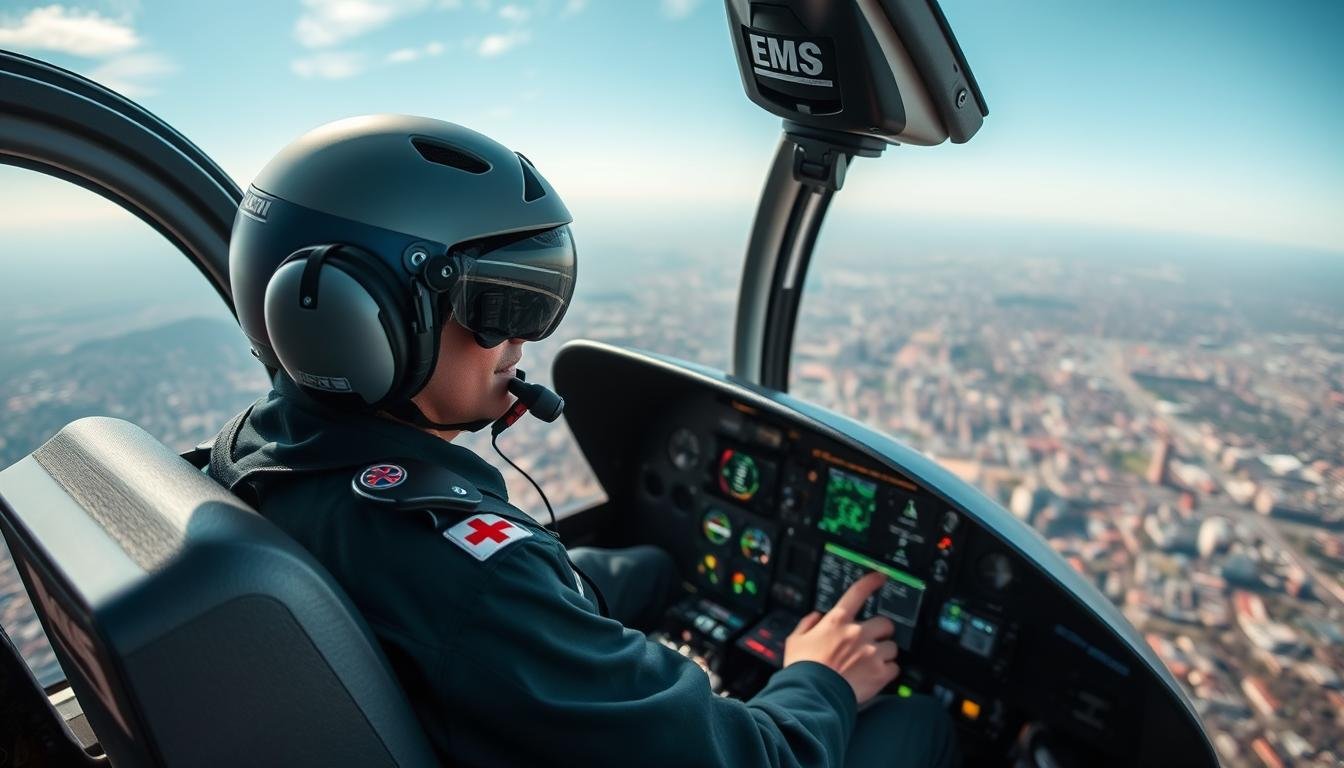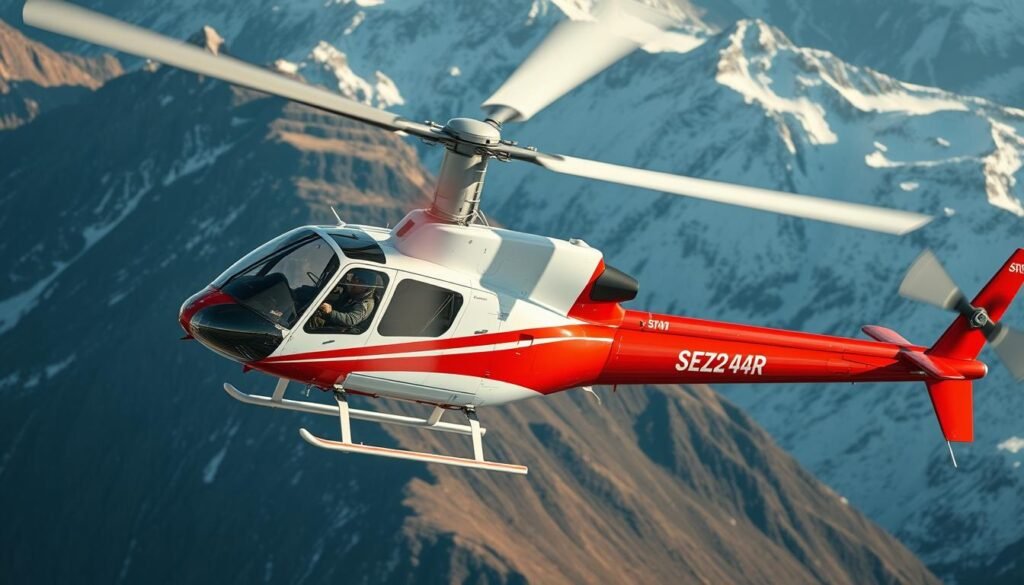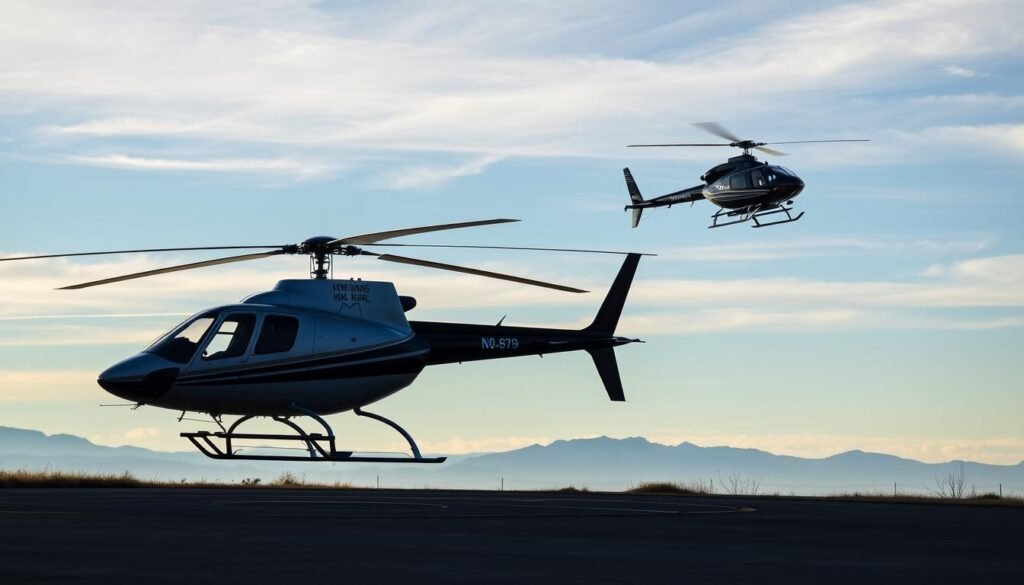Fact: Air ambulances can reach critical patients in a fraction of the time—often cutting transport time by more than half compared with ground units.
The transition from service aviation into civilian emergency medical flight roles is realistic and structured. This section explains the key steps, required certifications, and hour-building strategies that align military experience with employer standards.
They will learn the certification stack—private, instrument, commercial, and the FAA medical—plus how turbine time and instructor work shorten the path. Expectations on physical readiness and base schedules are covered plainly.
This intro previews timelines (roughly three to five years for readiness), logbook focus, and the teamwork that makes emergency response effective. For context on pay and hours needed at each stage, see a practical salary overview for a helicopter pilot.
Key Takeaways
- Air ambulance work combines fast decision-making with close medical crew coordination.
- A clear certification stack maps military quals to civilian standards.
- Building hours, including turbine time, is often achieved via instructing roles.
- Most pilots reach EMS readiness in about 3–5 years depending on opportunities.
- Physical and FAA medical standards are essential from day one.
Why EMS Helicopter Piloting Is A High-Impact Military Transition Path
Air ambulance work places a pilot at the center of life-saving missions that demand speed, precision, and steady judgment.
Crews transport patients and medical crews in time-sensitive conditions. Flights often happen at night, in marginal weather, and into confined areas like highways or hospital helipads.
Operators expect quick launches, NVG operations, and strong instrument proficiency. Schedules commonly follow a 7 days on / 7 days off rhythm with 12–14 hour shifts, so readiness and stamina matter.
Safety and crew resource management shape every mission. Checklists, recurrent training, and standardized procedures mirror service aviation culture and help pilots manage risk in complex environments.
- Mission focus: The job rewards fast decision-making and disciplined flying.
- Teamwork: Pilots coordinate closely with medical crews and ground services.
- Operational range: Bases span rural valleys to dense urban airspace and coastal weather.
For a closer look at operational challenges that affect daily flying, see challenges faced by helicopter pilots in emergency.
Military To EMS Helicopter Career Pivot Guide: Translating Service Experience Into Civilian Aviation
Translating logged mission experience into civilian currency requires a focused plan and clear documentation.
Map Military Flight And Mission Skills To EMS Helicopter Operations
Service mission planning, crew coordination, checklist discipline, and risk management align directly with emergency operations. He or she should inventory logbooks and tag PIC, night, instrument, cross-country, and turbine entries for civilian review.
Identify Civilian Certificates, Ratings, And Medical Requirements
Required certifications typically include a private rotorcraft certificate, instrument rating, and commercial rotorcraft certificate. Most operators list 1,500–2,500 total hours, with common thresholds: 1,000–1,500 PIC helicopter and 500–1,000 turbine hours. A first or second-class FAA medical is standard; ATP may be preferred by some employers.

Plan A Realistic Transition Timeline In The United States
A 3–5 year timeline sets milestones for hours, instrument currency, and turbine experience. Schedule the FAA medical early and target roles that deliver turbine and night time while keeping instrument currency current.
“Inventory service evaluations and document all training. Clear records speed hiring and reduce surprises during chief pilot reviews.”
| Milestone | Target Hours | Notes |
|---|---|---|
| Total Time | 1,500–2,500 | Employer dependent; aim for 2,000+ |
| PIC Helicopter | 1,000–1,500 | Emphasize unaided night where possible |
| Turbine | 500–1,000 | Seek turbine instructor or operator roles |
| Instrument | 75–100 | Maintain IFR recency |
- Align military evaluations with civilian documentation for HR review.
- Prioritize NVG and night hours if operator requirements list them.
- Choose training paths offering turbine platforms and instrument recurrency.
For employer options and hiring standards, review this list of top operators hiring helicopter pilots.
Step-By-Step Training And Certification For EMS Helicopter Pilots
Structured progression helps a candidate move from basic ground work to instrument-capable, commercial readiness. Each phase aligns bench tests, flight hours, and medical screening with operator standards.

Private Helicopter Pilot License: Ground, Flight Training, And Flight Time
Private license builds fundamentals through ground school, dual instruction, and solo practice. FAA minimums are 35–40 hours but most students need 50–60 hours focused on hovering, emergency procedures, navigation, and confined-area ops.
Instrument Certification: IFR Skills For Weather And Night Flying
Instrument training creates IFR proficiency for low-visibility and night conditions. A common roadmap includes about 15 hours of instruction, 40 hours of instrument time, and 50 hours cross-country, plus FAA written and checkride completion.
Commercial Rotorcraft Certificate: Advanced Maneuvers And Compliance
The commercial certificate demands precision: autorotations, confined-area work, and regulatory knowledge. Under Part 141, expect roughly 115 hours toward this goal and rigorous written and oral exams.
FAA Medical Certificate: First Or Second Class Standards And Renewals
Pilots must obtain a first or second-class FAA medical via an AME. The exam checks vision, hearing, cardiovascular health, and overall fitness. Early screening prevents delays and protects training timelines.
For a practical enrollment and step checklist, see how to become a helicopter pilot.
Building Flight Time And Experience That Employers Value
Building targeted flight hours and operational experience makes a pilot visibly ready for life‑saving rotor operations. This section lays out a concise hour plan and practical paths that prove readiness for base-level standardization checks.

Become A Flight Instructor To Accelerate Hours And Skills
Serving as an instructor remains the fastest, most respected route to build flight time while sharpening judgment and communication. Instructing develops stick-and-rudder finesse, emergency procedure drills, and CRM that employers demand.
Accumulate Turbine Time In Operational Aircraft
Pursue tour, utility, or survey roles that use turbine platforms. Turbine time under operational pressure demonstrates systems management and prepares a pilot for the turbine fleets common in ems operations.
Night Flying, NVG, Cross-Country, And Instrument Time Targets
Target employer thresholds precisely: about 2,000 total hours, 1,200–1,500 helicopter, 1,000–1,500 PIC, 500–1,000 turbine, 100 night (unaided preferred), and 75–100 instrument.
- Plan logbook entries strategically so each hour counts toward employer minimums.
- Prioritize NVG and night flying currency when available.
- Blend simulated and actual instrument time to meet instrument targets.
- Use cross-country missions to refine navigation, fuel planning, and weather decisions.
Audit the logbook regularly. Accurate categorization turns generic time into verifiable, mission-relevant experience that speeds interviews and assignment offers.
The Operational Reality: Duties, Procedures, And Safety In EMS
Operational tempo in aeromedical flight demands steady judgment and immediate readiness for unpredictable missions.
Work Schedules, Weather, And Environment: From Rural To Urban Bases
Bases commonly run 7-on/7-off rotations with 12–14 hour shifts. Pilots must remain launch-ready for day and night calls.
Weather and local conditions drive go/no-go decisions. Teams use disciplined risk assessment and company SOPs before each launch.
Environments vary widely: rural fields, rooftop hospital pads, and confined roadside scenes require different approach techniques.

Preflight Checks, Load Management, And Regulatory Compliance
Pilots perform methodical preflight checks and verify aircraft systems every shift. Weight-and-balance calculations ensure patients, crew, and gear fit safe limits.
Procedures include strict checklist usage, passenger briefings, and fuel planning tailored to mission range and weather forecasts.
Close coordination with flight nurses, paramedics, dispatch, and receiving hospitals speeds patient care while protecting safety margins.
- Flight documentation: Logbooks and reports record every mission for compliance and safety review.
- Training cadence: Recurrent NVG, instrument, and CRM events keep pilots current with standards.
- Safety culture: Line checks and SMS feedback drive continuous improvement across operations.
“Pilots balance patient urgency with sound aeronautical decision-making, resisting pressure that risks safety.”
For deeper operational research and standards, see this operational safety research.
HEMS Employers And Compensation Landscape In The United States
The industry blends national leaders and regional operators that set pay, benefits, and hiring standards for rotor flight pilots.

Major Operators Snapshot
Air Methods, PHI Air Medical, GMR brands, Metro Aviation, and Life Flight Network dominate the services market.
Air Methods runs 450+ aircraft and 300+ bases, with VFR pay near $82,900–$93,251 and ACCRA adjustments up to 120%. PHI offers large sign-on/retention packages. Life Flight Network and GMR provide strong benefits and retention incentives.
Standard Requirements
Typical requirements include 1,500–2,500 total hours, 1,200–1,500 helicopter, 1,000–1,500 PIC, 500–1,000 turbine, ~100 night, and 75–100 instrument hours.
Pay, Bonuses, And Benefits
Base salaries in 2025 range roughly $68,000–$85,000 entry and $85,000–$120,000+ for experienced pilots.
Total compensation can exceed $150,000–$235,000 with sign-on, retention, stipends, and housing. Typical incentives include $2,000–$25,000 sign-on and retention up to $100,000 at times.
Geographic And Base Factors
Location premiums matter: California and the Northeast often add 20–40% pay. Rural bases may offset lower base pay with housing, travel support, and annual stipends.
Challenges, Standards, And Career Progression In EMS Aviation
High operational tempo and steady training demands create real stress points for pilots moving into aeromedical work.
Financial Commitment, Medical Fitness, And Industry Standards
Funding training and certification takes planning. Ratings, simulator blocks, and recurrent checks add up before steady pay begins.
Pilots must maintain a first or second-class FAA medical and meet base weight limits. Regular renewals and fitness checks are common.
Operators enforce tight standards: NVG recency, instrument proficiency, CRM, and emergency procedure drills appear on every recurrent schedule.
Career Growth: Check Airman, Instructor, Leadership, And Technology Upskilling
Promotion follows proven skills, recurrent training, and varied experience in mountain, coastal, or urban weather.
Paths include instructor roles, check airman, base chief pilot, and regional management. Additional credentials such as ATP or relevant degrees help.
| Progression Role | Typical Requirements | Benefits |
|---|---|---|
| Flight Instructor | Commercial cert, CFI, logged hours | Rapid hour building, teaching skills |
| Check Airman | Operational experience, evaluator quals | Higher pay, training oversight |
| Chief Pilot / Manager | Leadership, admin, safety background | Career stability, strategic influence |
| Specialist / Tech Upskill | Avionics, NVG, synthetic vision training | Improved mission safety, niche roles |
Plan deliberate development with simulator sessions and instrument refreshers. For a comparison of program options and hiring paths, review this career paths comparison.
Action Plan For Military Pilots: From Today To First EMS Base Assignment
A short, discipline-focused checklist helps a pilot close gaps and present a clean package to operators. This action plan lays out a 90-day sprint and a targeted networking approach that speeds the path to a first base assignment.
90-Day Checklist: Training Enrollments, Medical, And Logbook Alignment
Within 90 days, schedule the FAA medical with an AME and audit logbooks for category accuracy: TT, helicopter, PIC, turbine, night, instrument, and cross-country.
Enroll in any missing training to close gaps in instrument, night, or turbine experience. Maintain NVG and instrument currency as required by many operators.
- Update military training records, NVG quals, and safety awards and convert terms into civilian abbreviations.
- Prepare incident stories that show sound decision-making and adherence to procedures under pressure.
- Assemble a concise packet: resume, certificates, medical, and logbook summaries by category.
Targeted Networking: Operators, Recruiters, And Base Preferences
Contact major operators and recruiters directly and state specific base preferences and schedule flexibility.
- Reach out to Air Methods, PHI, GMR brands, Metro Aviation, and Life Flight Network; include preferred locations and readiness for 7-on/7-off work.
- Attend job fairs, request informational calls with chief pilots, and seek referrals from former supervisors and instructors.
- Prepare references who can vouch for flight discipline, safety culture, and mission leadership.
“Align logbooks and medical early. Clear records and targeted outreach cut hiring friction and speed placement.”
Reassess progress monthly. Update hour tallies, track currency, and refine applications until an offer and base assignment are secured. For help crafting application materials, review this cover letter example.
Final Thoughts
A disciplined plan and steady training convert logged flight hours into hireable, mission-ready skills.
The ems helicopter path offers a purpose-driven career where flying proficiency directly affects patient outcomes. Candidates must secure private, instrument, and commercial certification, keep a current FAA medical, and build turbine and night time.
Clear records, focused hour-building, and strong communication with medical crews and dispatch show the ability to handle weather and complex conditions. Competitive pay and benefits reward readiness, and long-term vision includes instructor, check airman, and leadership roles.
Next steps: finalize the medical, close any training gaps, expand networking, and pursue base options that match skills and family needs. For transition resources, see this overview from military to civil aviation:
From Military To Civil Aviation
FAQ
How do military rotary-wing hours translate to civilian pilot hiring minimums?
Hiring managers evaluate total pilot-in-command time, turbine experience, and mission-relevant hours. Many operators require 1,200–1,500 total hours with a significant portion in turbine helicopters. Service pilots should log task-based sorties, NVG, night, and instrument approaches clearly in their logbooks to match those civilian metrics.
Which civilian certificates and ratings must a service rotorcraft pilot obtain?
Candidates need a commercial rotorcraft certificate, instrument rating (if pursuing IFR operations), and often a certified flight instructor (CFI) certificate to build hours. An FAA first- or second-class medical certificate is mandatory, and some employers expect an instrument competency check or type-specific training for turbine aircraft.
What is the realistic timeline for completing required training and currency?
A practical transition spans 9–18 months for most former service pilots. This includes converting military experience to a civilian logbook, completing any required civil flight training, instrument work, and obtaining the FAA medical. Time varies with prior hours, access to turbine flight time, and scheduling for checkrides.
Can becoming a flight instructor accelerate the path to an EMS pilot role?
Yes. Serving as a CFI or CFII accelerates useful hours, sharpens teaching and CRM skills, and demonstrates currency. Many employers value instructional experience because it builds safe decision-making, SOP adherence, and cross-checking habits directly applicable to emergency missions.
How important is turbine time and how can one gain it?
Turbine time is highly valued. Options include working for Part 135 operators, turbine transition programs offered by vendors like Airbus Helicopters, or entry-level roles in offshore, utility, or charter operations. Accumulating turbine hours improves competitiveness for air medical employers.
What night and NVG experience do operators require?
Many programs require night flying experience and NVG training for night flight operations. Operators often set minimum night hours and NVG currency; some provide NVG qualification during company training but prefer applicants who already hold basic night and instrument experience.
What medical standards and fitness considerations apply for air medical pilots?
Pilots must hold an FAA first- or second-class medical certificate, depending on the operation. Employers may require additional health screenings, vision standards, and physical fitness to handle hoists, cabin work, and patient loading. Staying current on renewals prevents disqualification during hiring.
How do weather and instrument skills affect eligibility for emergency flight crews?
Strong instrument skills and sound weather decision-making are critical. Many agencies operate in marginal conditions, so IFR competence, cross-country instrument time, and demonstrated weather assessment reduce risk and increase hireability for both pilots and medical crews.
What typical pay, bonuses, and benefits can pilots expect in air medical operations?
Compensation varies by operator and location. Entry-level turbine pilots may start lower but see step increases with PIC and turbine time. Employers often offer sign-on bonuses, housing stipends, health benefits, retirement plans, and training allowances. Remote or high-demand bases may pay premiums.
Which employers in the U.S. are major players in air medical services?
Notable operators include Air Methods, PHI Air Medical, GMR, Metro Aviation, and Life Flight Network. Each has unique hiring standards, aircraft fleets, and base distributions. Researching specific operator requirements helps tailor training and networking efforts.
What are the key nonflying skills that increase a candidate’s value?
Crew resource management, patient-loading procedures, load manifesting, regulatory compliance familiarity, and strong communication with medical teams matter. Leadership, adaptability to austere environments, and proficiency with SOPs and safety management systems are valued.
How should service pilots document military experience for FAA and employers?
Maintain detailed log entries showing task, aircraft type, duration, and conditions. Translate military mission descriptions into civilian flight tasks (e.g., instrument approaches, external load operations). Use FAA letter of authorization processes when applicable and obtain military-to-civil conversion endorsements when required.
What financial commitment is typical for the transition process?
Costs include flight training, checkrides, medical exams, and time spent building hours. Depending on prior qualifications, candidates may invest tens of thousands of dollars. Many offset costs by instructing, taking turbine entry roles, or using veteran education benefits.
What career progression paths exist after joining an air medical operator?
Progression often moves from co-pilot to pilot-in-command, then base lead, check airman, instructor, or into safety and management roles. Technology upskilling, recurrent training, and leadership development facilitate advancement within operators and across the industry.
How should a transitioning pilot approach networking and recruiter outreach?
Targeted networking includes contacting operators’ hiring teams, attending industry events like HAI Heli-Expo, joining associations such as AAMS, and leveraging contacts from veterans’ aviation programs. Present a clear resume, current logbook, and documented medical and training records.
What are common operational realities new hires should expect on the job?
New pilots face irregular schedules, night missions, variable weather, and rapid shifts between clinical and flight duties. Expect rigorous preflight checks, strict SOPs, and a safety-first culture. Familiarity with patient care workflows and working alongside medical crews is essential.



